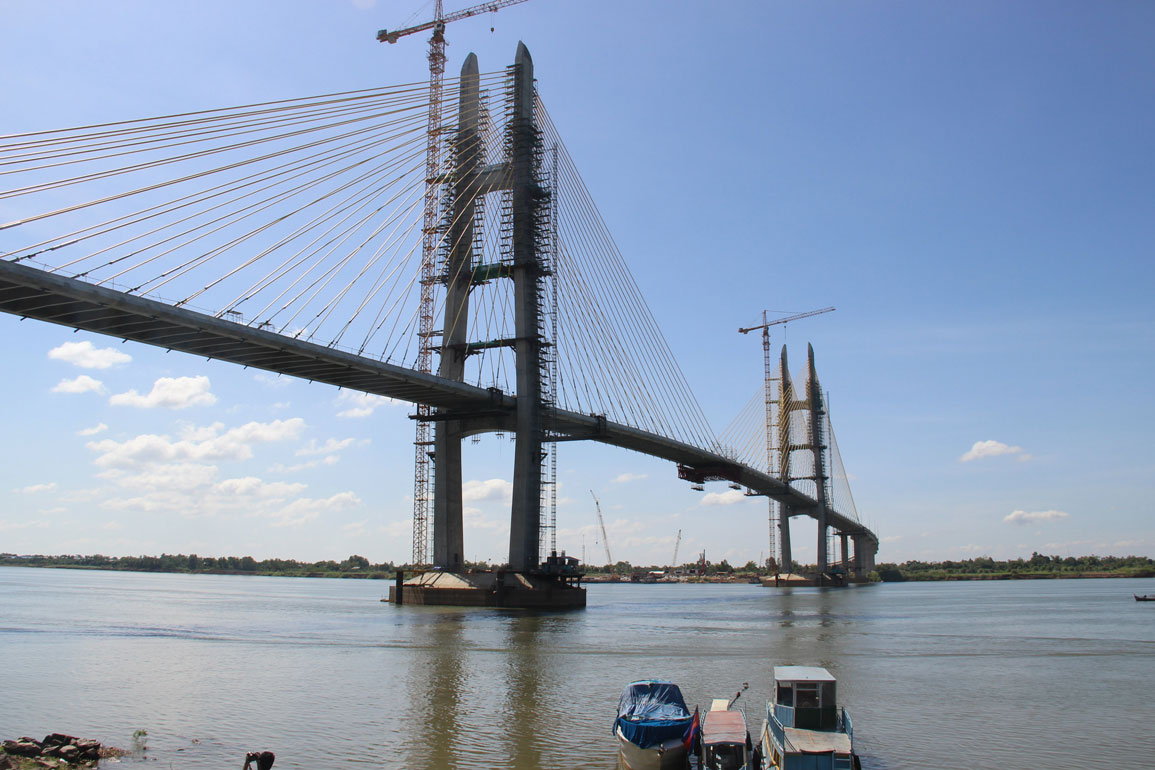ផ្លូវមួយខ្សែភ្ជាប់ពីផ្លូវជាតិលេខ៦ ដល់តំបន់ទេសចរណ៍កំពង់ភ្លុក សាងសង់បាន ៧០% ហើយ
គម្រោងអភិវឌ្ឍន៍ហេដ្ឋារចនាសម្ព័ន្ធដ៏សំខាន់មួយកំពុងដំណើរការនៅក្នុងខេត្តសៀមរាប ដែលមានផ្លូវប្រវែង ១៥គីឡូម៉ែត្រ តភ្ជាប់ពីផ្លូវជាតិលេខ៦ ទៅកាន់តំបន់ទេសចរណ៍កំពង់ភ្លុក ពេលនេះសម្រេចបានប្រមាណ ៧០% ហើយ។ នេះបើយោងតាមការប្រកាសរបស់រដ្ឋបាលខេត្តសៀមរាប នៅថ្ងៃទី៣ ខែឧសភា ឆ្នាំ២០២៥។ រដ្ឋបាលខេត្តសៀមរាប បានឱ្យដឹងថា ផ្លូវមួយខ្សែនេះ មានទទឹង ៨ម៉ែត្រ និងប្រវែង ១៥គីឡូម៉ែត្រ គឺជាអំណោយរបស់សម្តេចនាយករដ្ឋមន្ត្រី ហ៊ុន ម៉ាណែត ជូនពលរដ្ឋដែលរស់នៅក្នុងឃុំកំពង់ភ្លុក ស្រុកប្រាសាទបាគង និងសហគមន៍ទេសចរណ៍ ដើម្បីបម្រើផលប្រយោជន៍ក្នុងការដឹកជញ្ជូនផលនេសាទ និងធ្វើជាផ្លូវដ៏សំខាន់សម្រាប់ភ្ញៀវទេសចរដែលមកទស្សនាបឹងទន្លេសាបដ៏ស្រស់ត្រកាល។ គួរបញ្ជាក់ថា ផ្លូវមួយខ្សែនេះ ត្រូវបានសាងសង់ដោយក្រុមការងារកងវិស្វកម្មតេជោ ហ៊ុន សែន ដែលគ្រោងនឹងបញ្ចប់ក្នុងខែកក្កដា ឆ្នាំ២០២៥ ខាងមុខនេះ។ ផ្លូវនេះ ត្រូវបានបែងចែកជាពីរប្រភេទសម្រាប់ការងារសាងសង់, ទី១ គិចចាប់ពីផ្លូវជាតិលេខ៦ ដល់ភូមិតាប្រាក់ ឃុំមានជ័យ ត្រូវបានសាងសង់ជាប្រភេទផ្លូវបេតុង, ទី២ ជាប្រភេទផ្លូវក្រាលកៅស៊ូខ្លះ និងបេតុងខ្លះ ដោយក្នុងនោះមានសង់ផ្លូវបេតុងប្រវែង ៣,២៥គីឡូម៉ែត្រ និងផ្លូវក្រាលកៅស៊ូប្រវែង ៩គីឡូម៉ែត្រ គិតចាប់ពីភូមិតាប្រាក់ ទៅដល់ចំណតទូកឃុំកំពង់ភ្លុក។ អាជ្ញាធរខេត្តបានបញ្ជាក់បន្ថែមថា នៅឆ្នាំក្រោយ នឹងមានគម្រោងសាងសង់ផ្លូវបន្តពីចំណតទូកឃុំកំពង់ភ្លុកទៅសាលាឃុំកំពង់ភ្លុកថែមទៀតផង។ តាមរយៈផ្លូវនេះ […]
គម្រោងសង់ប្រព័ន្ធដោះទឹកតាមបណ្តោយផ្លូវជាតិលេខ៤ សម្រេចបាន ៩៣% ហើយ
គិតមកដល់ពេលបច្ចុប្បន្ន គម្រោងសាងសង់ហេដ្ឋារចនាសម្ព័ន្ធប្រព័ន្ធលូ និងប្រព័ន្ធដោះទឹក ដើម្បីបញ្ចៀសការជន់លិចនៅភូមិសាស្ត្ររាជធានីភ្នំពេញ (តាមបណ្តោយផ្លូវជាតិលេខ៤ និងផ្លូវរថភ្លើង) សម្រេចបាន ៩៣% ហើយ។ នេះបើយោងតាមការចុះពិនិត្យគម្រោងផ្ទាល់ ដែលដឹកនាំដោយឯកឧត្តម ហ៊ាង វុត្ថា អគ្គនាយក នៃអគ្គនាយកដ្ឋានបច្ចេកទេស និងជាប្រធានក្រុមការងារបច្ចេកទេសគម្រោង និង ឯកឧត្តម ចៅ សុភៈភិបាល អគ្គនាយក នៃអគ្គនាយកដ្ឋានប្រព័ន្ធចម្រោះទឹកកខ្វក់ នៃក្រសួងសាធារណការ និងដឹកជញ្ជូន នៅថ្ងៃទី០២ ខែមិថុនា ឆ្នាំ២០២៥។ គោលបំណងសំខាន់នៃការចុះពិនិត្យផ្ទាល់នេះ គឺដើម្បីតាមដានវឌ្ឍនភាពលើដំណើរការអនុវត្តការងារទាំងទិដ្ឋភាពជារួម និងផ្នែកបច្ចេកទេស ក៏ដូចជាប្រសិទ្ធភាពនៃប្រព័ន្ធ និងពិភាក្សាលើចំណុចបច្ចេកទេសដែលគួរកែសម្រួល ព្រមទាំងពិនិត្យលើភាពអសកម្មមួយចំនួន រួមទាំងផលប៉ះពាល់ផ្សេងៗផងដែរ។ នាឱកាសនោះ ឯកឧត្តម ហ៊ាង វុត្ថា និងឯកឧត្តម ចៅ សុភៈភិបាល បានស្នើឱ្យក្រុមការងារ មន្ត្រីបច្ចេកទេស និងក្រុមហ៊ុនសាងសង់ បន្តយកចិត្តទុកដាក់បន្ថែមទៀតទៅលើពេលវេលានៃការអនុវត្តគម្រោង ដើម្បីអាចបញ្ចប់ការងារនេះទៅតាមផែនការដែលបានគ្រោងទុក។ គួរបញ្ជាក់ថា គម្រោងសាងសង់ដាក់លូ និងប្រព័ន្ធរំដោះទឹកសម្រាប់បញ្ចៀសការជន់លិចនៅភូមិសាស្ត្ររាជធានីភ្នំពេញត្រូវបានអនុវត្តសាងសង់ដោយក្រុមហ៊ុន PHNOM PENH PRECAST PLANTS CO., LTD […]
ក្រុមហ៊ុន NTT ចង់ពង្រីកការវិនិយោគរបស់ខ្លួន ផ្តោតលើការអភិវឌ្ឍវិស័យឌីជីថលនៅកម្ពុជា
ក្រុមហ៊ុន NTT DOCOMO GLOBAL Inc., របស់ជប៉ុន បានបង្ហាញបំណងក្នុងការស្វែងរកឱកាសវិនិយោគ ដើម្បីពង្រីកសេវាគ្របដណ្តប់ និងអភិវឌ្ឍវិស័យឌីជីថលនៅកម្ពុជា សំដៅរួមចំណែកដល់ការអភិវឌ្ឍសង្គមឌីជីថលកម្ពុជាកាន់តែប្រសើរ។ បំណងនេះ បានបង្ហាញដោយលោក HIROKI Kuriyama ប្រធាន និងជានាយកប្រតិបត្តិ នៃក្រុមហ៊ុន NTT DOCOMO GLOBAL Inc., ក្នុងជំនួបជាមួយសម្តេចនាយករដ្ឋមន្រ្តី ហ៊ុន ម៉ាណែត នៅថ្ងៃទី២៨ ខែឧសភា ឆ្នាំ២០២៥។ ក្នុងជំនួបនោះ លោក HIROKI Kuriyama ប្រធានក្រុមហ៊ុន បានបង្ហាញពីគោលបំណងក្នុងការស្វែងរកឱកាសវិនិយោគនៅកម្ពុជា ជាពិសេសក្នុងវិស័យឌីជីថល ដើម្បីរួមចំណែកដល់ការអភិវឌ្ឍសេដ្ឋកិច្ច និងសង្គមឌីជីថលនៅកម្ពុជាបន្ថែមទៀត។ ជាការឆ្លើយតប សម្ដេចធិបតី បានស្វាគមន៍គោលបំណងរបស់ក្រុមហ៊ុនក្នុងការស្វែងរកឱកាសវិនិយោគនៅកម្ពុជាក្នុងការអភិវឌ្ឍវិស័យឌីជីថល ជាពិសេសការពង្រីកសេវាគ្របដណ្តប់ និងអភិវឌ្ឍហេដ្ឋារចនាសម្ព័ន្ធឌីជីថល ដើម្បីឱ្យពលរដ្ឋគ្រប់រូបមានឱកាសកាន់តែច្រើនក្នុងការប្រើប្រាស់បច្ចេកវិទ្យាឌីជីថល។ សម្ដេចបន្តថា បច្ចុប្បន្ន ក្រសួងស្ថាប័នពាក់ព័ន្ធកម្ពុជា កំពុងបញ្ចប់ដំណើរការ និងត្រៀមដាក់ឱ្យប្រើប្រាស់បច្ចេកវិទ្យា 5G នៅទូទាំងប្រទេសផងដែរ។ បន្ថែមពីនេះ សម្ដេចក៏បានណែនាំឱ្យក្រុមហ៊ុនបន្តពិភាក្សាជាមួយក្រសួងប្រៃសណីយ៍ និងទូរគមនាគមន៍ ដើម្បីសិក្សាលម្អិតអំពីលទ្ធភាពវិនិយោគលើវិស័យឌីជីថលកម្ពុជា។ សូមជម្រាប់ថា ក្រុមហ៊ុន […]
អង្គការពាណិជ្ជកម្ម JETRO ប្តេជ្ញាបន្តជំរុញការវិនិយោគរបស់ជប៉ុននៅកម្ពុជាឱ្យរិតតែប្រសើរបន្ថែមទៀត
នៅក្នុងការផ្លាស់ប្តូរដ៏សំខាន់មួយក្នុងការពង្រឹងទំនាក់ទំនងសេដ្ឋកិច្ច អង្គការពាណិជ្ជកម្មក្រៅប្រទេសជប៉ុន (JETRO) បានបញ្ជាក់ជាថ្មីពីការប្តេជ្ញាចិត្តរបស់ខ្លួនក្នុងការលើកកម្ពស់ការវិនិយោគរបស់ជប៉ុននៅក្នុងប្រទេសកម្ពុជា។ ការប្រកាសនេះធ្វើឡើងក្នុងជំនួបផ្លូវការរវាងសម្តេចនាយករដ្ឋមន្រ្តី ហ៊ុន ម៉ាណែត និងលោក ISHIGURO Norihiko ប្រធាន និងជានាយកប្រតិបត្តិរបស់ JETRO ក្នុងដំណើរទស្សនកិច្ចនៅទីក្រុងតូក្យូ ពីថ្ងៃទី ២៨-៣១ ខែឧសភា ឆ្នាំ២០២៥។ ក្នុងកិច្ចពិភាក្សារបស់ពួកគេ លោក Norihiko បានសម្តែងការសាទរចំពោះកិច្ចសហប្រតិបត្តិការជាបន្តបន្ទាប់ជាមួយសភាពាណិជ្ជកម្មកម្ពុជាក្នុងការរៀបចំវេទិកាធុរកិច្ចកម្ពុជា-ជប៉ុននៅទីក្រុងតូក្យូ។ វេទិកានេះបានទាក់ទាញអ្នកតំណាងធុរកិច្ចជប៉ុននិងកម្ពុជាមកចូលរួមយ៉ាងច្រើនក្នុងគោលបំណងលើកកម្ពស់ទំនាក់ទំនងពាណិជ្ជកម្មទ្វេភាគី។ លោក Norihiko ក៏បានលើកឡើងពីផែនការសម្រាប់គណៈប្រតិភូ JETRO ដែលនឹងនាំអ្នកវិនិយោគជប៉ុនមកកម្ពុជា ដើម្បីស្វែងរកឱកាសវិនិយោគថ្មីៗនៅពេលខាងមុខ។ លោកនាយករដ្ឋមន្ត្រី បានកោតសរសើរចំពោះតួនាទីដ៏សំខាន់របស់ JETRO ក្នុងការសម្របសម្រួលវេទិកាធុរកិច្ច ដោយសង្កត់ធ្ងន់លើសារៈសំខាន់របស់ខ្លួនជាវេទិកាសម្រាប់ពង្រឹងទំនាក់ទំនងពាណិជ្ជកម្មកម្ពុជា-ជប៉ុន។ លោកបានរំលឹកឡើងវិញនូវយុទ្ធសាស្ត្ររបស់រាជរដ្ឋាភិបាលក្នុងការទាក់ទាញការវិនិយោគពីបរទេសតាមរយៈការលើកទឹកចិត្តផ្សេងៗ និងការប្តេជ្ញាចិត្តក្នុងការកែលម្អហេដ្ឋារចនាសម្ព័ន្ធ ជាពិសេសផ្នែកភស្តុភារ។ គម្រោងសំខាន់ៗរួមមានការអភិវឌ្ឍន៍បណ្តាញផ្លូវថ្នល់ អាកាសយានដ្ឋានអន្តរជាតិ និងកំពង់ផែទឹកជ្រៅ។ ជាងនេះទៅទៀត លោកនាយករដ្ឋមន្ត្រីបានជំរុញឱ្យអ្នកវិនិយោគជប៉ុនពិចារណាលើការបង្កើតតំបន់សេដ្ឋកិច្ចពិសេសពិសេស (SEZs) ដែលសមស្របនឹងឧស្សាហកម្មរបស់ពួកគេ។ វិធីសាស្រ្តប្រកបដោយភាពច្នៃប្រឌិតនេះនឹងបង្កើតបរិយាកាសធុរកិច្ចអំណោយផលដែលត្រូវបានរចនាឡើងជាពិសេសសម្រាប់វិស័យមួយចំនួន បង្កើនភាពទាក់ទាញរបស់កម្ពុជាជាគោលដៅវិនិយោគ។ ពាក់ព័ន្ធនឹងផែនការបង្កើតតំបន់សេដ្ឋកិច្ចពិសេសតម្រូវតាមប្រភេទឧស្សាហកម្មនេះ កន្លងទៅមានវិទ្យាស្ថានស្រាវជ្រាវសេដ្ឋកិច្ចអាស៊ាន និងអាស៊ីបូព៌ា (Economic Research Institute for ASEAN and […]
អាជ្ញាធរខេត្តសៀមរាប និងខេត្តហឺណាន ប្តេជ្ញារួមគ្នាជំរុញកិច្ចសហការលើវិស័យអាទិភាព ដើម្បីពង្រឹងទំនាក់ទំនងទ្វេភាគី
ក្នុងការផ្លាស់ប្តូរដ៏សំខាន់ដើម្បីឆ្ពោះទៅរកការពង្រឹងទំនាក់ទំនងទ្វេភាគី រដ្ឋបាលខេត្តសៀមរាប និងខេត្តហឺណាន នៃសាធារណៈរដ្ឋប្រជាមានិតចិនបានប្តេជ្ញាចិត្តក្នុងការជំរុញកិច្ចសហប្រតិបត្តិការក្នុងវិស័យអាទិភាពមួយចំនួន។ ការសន្យានេះត្រូវបានធ្វើឡើងក្នុងអំឡុងពេលសន្និសីទអភិវឌ្ឍន៍ទេសចរណ៍ឆ្នាំ ២០២៥ ដែលធ្វើឡើងនៅទីក្រុង Kuqa តំបន់ស្វយ័តស៊ីនជាំង និងទីក្រុង Qingzhou ខេត្ត Henan ចាប់ពីថ្ងៃទី២៣ ដល់ថ្ងៃទី៣០ ខែឧសភា ឆ្នាំ២០២៥។ នាឱកាសនោះ លោក ង៉ូវ សេងកាក់ អភិបាលរងខេត្តសៀមរាប បានឱ្យដឹងថា សន្និសីទនេះ រៀបចំឡើង ដើម្បីផ្សព្វផ្សាយអំពីធនធាន និងផលិតផលទេសចរណ៍នៃស៊ីនជាំង ការចរចារធុរកិច្ចរវាងសហគ្រាស និងការត្រួតពិនិត្យផ្លូវទេសចរណ៍នានា ព្រមទាំងបង្កើតវេទិកាផ្លាស់ប្តូរទេសចរណ៍អន្ដរជាតិ និងសហប្រតិបត្តិការជាសហគមន៍ ដើម្បីលើកកម្ពស់កិច្ចសហប្រតិបត្តិការទេសចរណ៍ពហុភាគី វិភាគយុទ្ធសាស្ត្រយ៉ាងសំខាន់នៃការអភិវឌ្ឍន៍ទេសចរណ៍ និងសម្របសម្រួលគំនិតបង្កើតផែនការពង្រីកការទំនាក់ទំនងនាពេលអនាគត។ ទន្ទឹមគ្នានេះដែរ ដើម្បីពង្រឹងកិច្ចសហប្រតិបត្តិការខាងលើឱ្យឆាប់ទទួលបានជោគជ័យបន្ថែមទៀត លោកអភិបាលរងបានបញ្ជាក់ថា គណៈប្រតិភូខេត្តសៀមរាប បានបន្តជួបពិភាក្សាជាមួយលោកអភិបាលក្រុង Shingzhou ខេត្តហឺណាន ដើម្បីធ្វើការផ្លាស់ប្តូរយោបល់គ្នារកយុទ្ធសាស្រ្តជំរុញវិស័យអាទិភាពមួយចំនួនរួមមាន៖ ទេសចរណ៍ វប្បធម៌ កសិកម្ម ពាណិជ្ជកម្ម ឧស្សាហកម្ម និងការផ្លាស់ប្តូរនិស្សិតកម្ពុជាពីខេត្តសៀមរាបទៅកាន់ទីក្រុងសីងចូវនាពេលខាងមុខនេះផងដែរ។ គួរបញ្ជាក់ថា កន្លងទៅថ្មីៗនេះ សហគ្រាស នៃសភាពាណិជ្ជកម្មអន្តរជាតិចិន ដែលមាន ប្រមាណ ៤០ក្រុមហ៊ុន […]
ក្រុមហ៊ុនផ្តល់ប្រឹក្សាផ្នែកវិស្វកម្មមកពីជប៉ុន បង្ហាញចេតនាចង់វិនិយោគលើវិស័យប្រព្រឹត្តិកម្មទឹកកខ្វក់ នៅព្រះសីហនុ
ក្រុមហ៊ុន YACHIYO Engineering Co., Ltd. ដែលមានជំនាញប្រឹក្សាផ្នែកវិស្វកម្មដ៏ធំមួយនៅប្រទេសជប៉ុន បានបង្ហាញពីបំណងចង់ពង្រីកប្រតិបិត្តការរបស់ខ្លួនក្នុងគម្រោងអភិវឌ្ឍប្រព្រឹត្តិកម្មទឹកកខ្វក់ នៅក្នុងខេត្តព្រះសីហនុ។ នេះបើតាមជំនួបរវាងសម្ដេចនាយករដ្ឋមន្ត្រី ហ៊ុន ម៉ាណែត និងលោក DEMIZU Shigemitsu ប្រធានក្រុមហ៊ុន នៅក្នុងឱកាសនៃដំណើរទស្សនកិច្ចការងារផ្លូវការ ពីថ្ងៃទី២៨-៣១ ខែឧសភា ឆ្នាំ២០២៥ នៅទីក្រុងតូក្យូ ប្រទេសជប៉ុន។ ក្នុងជំនួបនេះ លោកប្រធានក្រុមហ៊ុន បានលើកឡើងអំពីវឌ្ឍនភាពនៃដំណើរការនៃគម្រោងមួយចំនួនរបស់ក្រុមហ៊ុននៅកម្ពុជាពាក់ព័ន្ធនឹងការកែច្នៃសំណល់។ ទន្ទឹមនឹងនេះ លោកក៏បានបើកបង្ហាញពីគោលបំណងរបស់ក្រុមហ៊ុនដែលចង់ពង្រីកការវិនិយោគអភិវឌ្ឍគម្រោង ប្រព្រឹត្តកម្មទឹកកខ្វក់នៅខេត្តព្រះសីហនុ ដោយបញ្ជាក់ថា ការវិនិយោគនេះ នឹងនាំមកជាមួយនូវបទពិសោធន៍ និងបច្ចេកវិទ្យាទំនើបមកកាន់ប្រទេសកម្ពុជា សំដៅរួមចំណែកដល់ការអភិវឌ្ឍសង្គម និងសេដ្ឋកិច្ច។ លោកប្រធានបានបន្ថែមថា ក្រុមហ៊ុនមានបច្ចេកវិទ្យាទំនើបក្នុងការដោះស្រាយបញ្ហាជំងឺឆ្លងតាមទឹកកខ្វក់ ដែលនឹងរួមចំណែកដល់ការលើកកម្ពស់សុខុមាលភាពប្រជាជន តាមរយៈការលើកកម្ពស់អនាម័យសាធារណៈ ក៏ដូចជាការចូលរួមអភិវឌ្ឍទីក្រុងឆ្លាតវៃផងដែរ។ ជាការឆ្លើយតប សម្តេចនាយករដ្ឋមន្រ្តី បានសម្តែងការស្វាគមន៍ និងវាយតម្លៃខ្ពស់ចំពោះក្រុមហ៊ុន ដែលកំពុងវិនិយោគលើគម្រោងការកែច្នៃសំណល់នៅកម្ពុជា។ លើសពីនេះ សម្តេចក៏គូសបានបញ្ជាក់ពីសេចក្តីត្រូវការរបស់ប្រជាពលរដ្ឋកម្ពុជាថា វាក៏មិនខុសពីសេចក្តីត្រូវការរបស់ប្រជាពលរដ្ឋជប៉ុននោះទេ ដែលការវិនិយោគលើការកែច្នៃសំណល់ និងការធ្វើប្រព្រឹត្តកម្មទឹកកខ្វក់ ពិតជាមានភាពចាំបាច់ណាស់ ដើម្បីឆ្លើយតបនឹងតម្រូវការ និងលើកកម្ពស់សុខុមាលភាពប្រជាពលរដ្ឋ។ គួរបញ្ជាក់ថា ACHIYO Engineering Co., […]



 English
English







